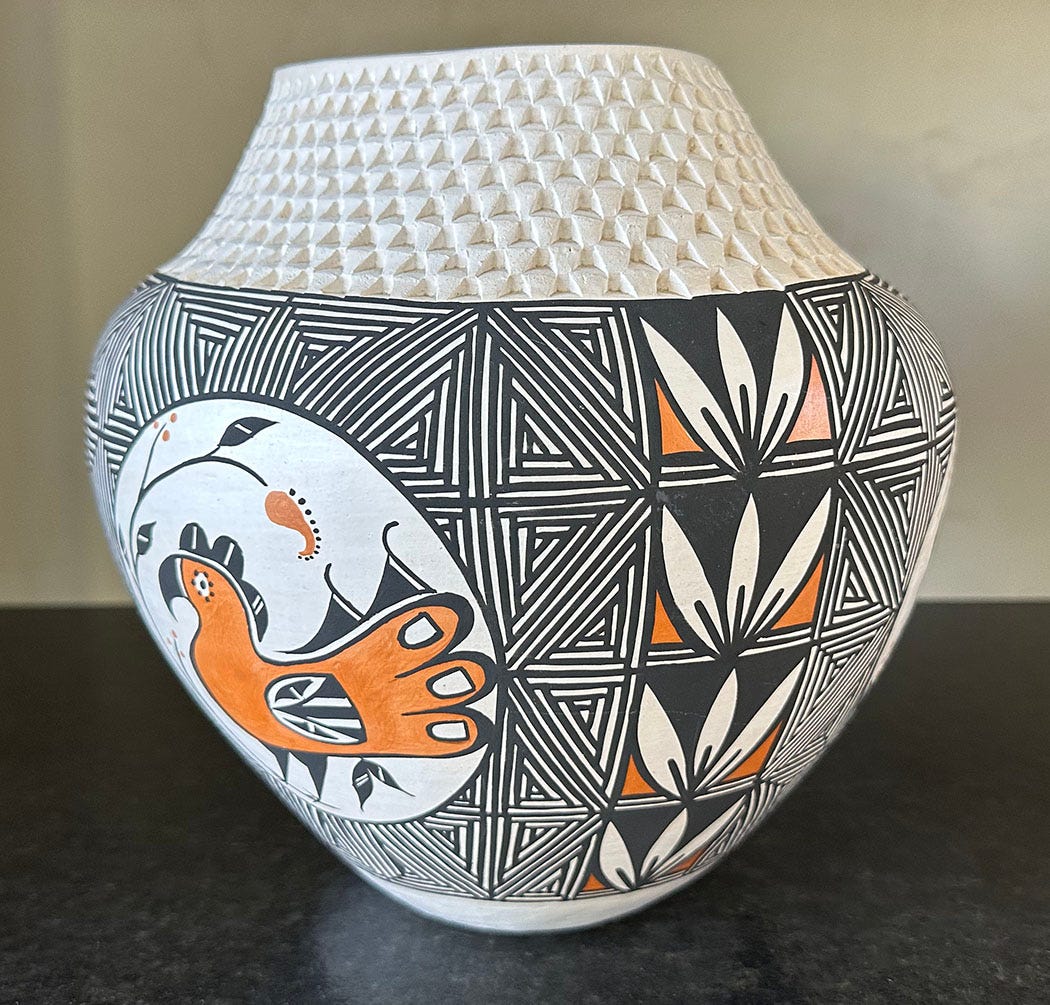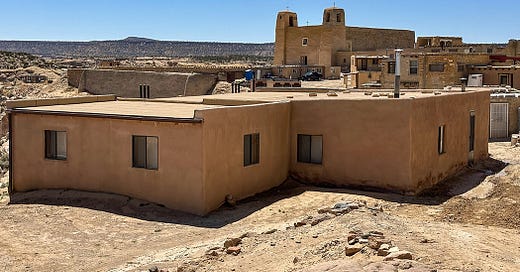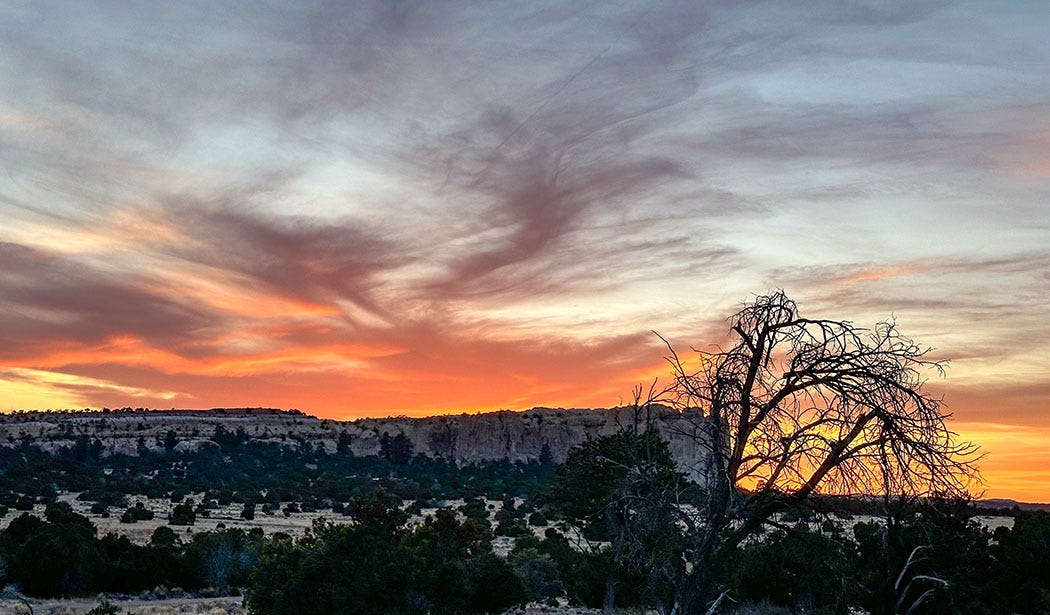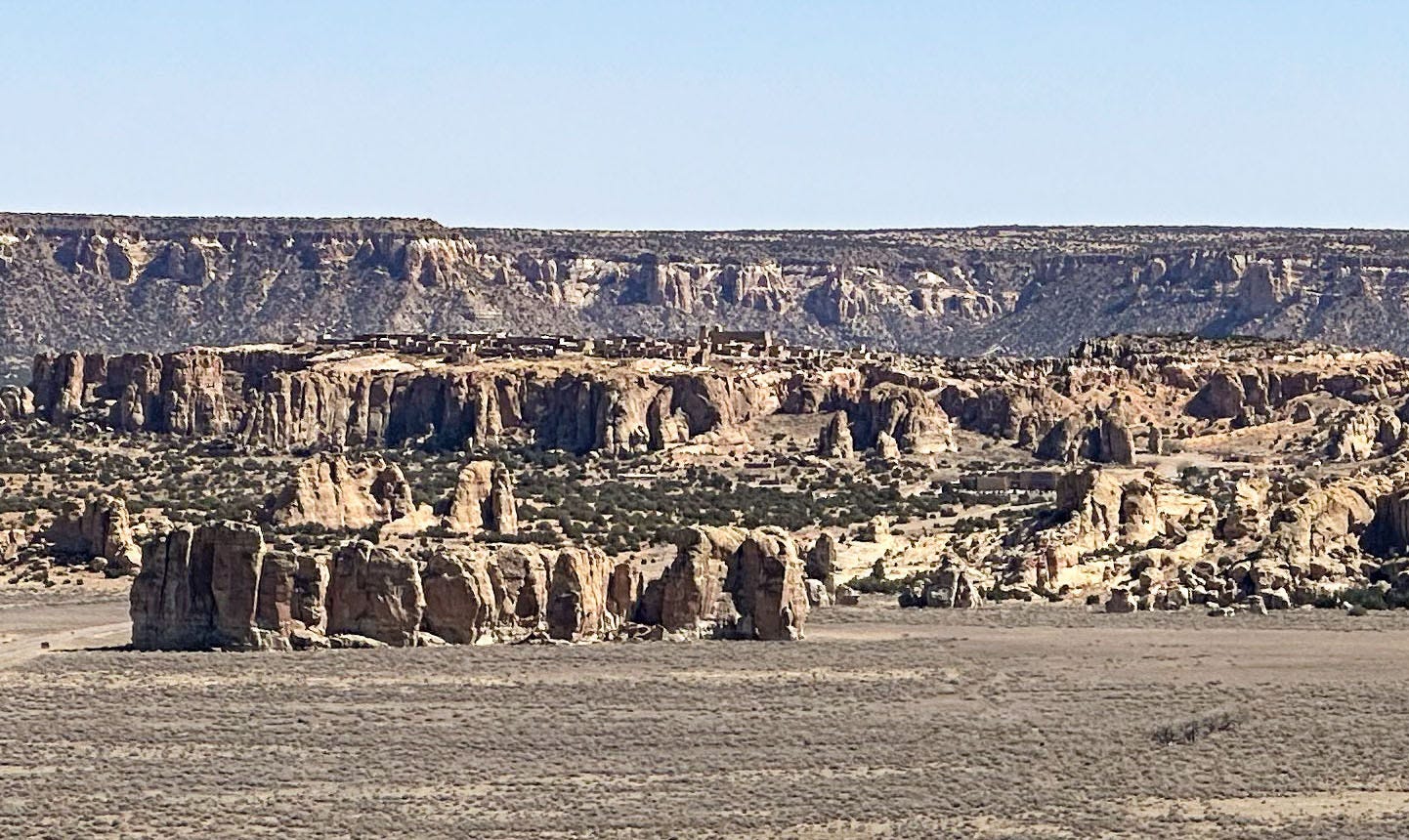Part 1: Zuni and Acoma
On a warm day in mid-April, we parked our adventure van next to a small Indigenous art gallery in New Mexico’s Zuni Pueblo. Crossing the highway, we climbed a staircase to an unpaved parking lot haphazardly strewn with cars, pickups and SUVs. Through a narrow alley we reached another short staircase, and climbed it onto the roof of a building overlooking a small communal plaza surrounded by two- and three-story dwellings.
The plaza, about half the size of an NBA basketball court, had a smooth surface of packed earth. There were 200 or so pueblo residents looking on; most were standing or sitting on the rooftops of the buildings enclosing it, but others were around the plaza perimeter at ground level on folding chairs, benches or in the windows of first-story rooms.
And then came the dancers, streaming into the plaza in a burst of color, sound and motion that is difficult to describe. There were 40 to 50 of them, wearing the masks and elaborate regalia of kachinas — spirit beings, in Zuni and Hopi cosmology, who serve as intermediaries between pueblo dwellers and the powerful deities believed to control sunshine, rain, fertility, illness and other major natural forces.
As drummers beat out a cadence, the colorfully costumed dancers stamped, jumped, ran and twirled to its rhythm, and the sound of bells and rattles affixed to their arms and legs joined occasional cries and shouts to build an evocative multi-sensory symphony. Feathers, furs and garlands of greenery adorned many of the dancers; two of them wore actual golden eagle wings affixed to their arms and seemed to be the focal point of much of the ritual, gracefully swooping together through the scrum of activity in imitation of a soaring bird.
It is not often that outsiders are allowed to witness such things, and our presence was utterly serendipitous. We learned of the opportunity only when we arrived at the Zuni village that day without any particular plans, registered at the visitor center and asked the host there how we should spend the rest of our day. He told us about the dance that afternoon, the finale of a six-day series of publicly accessible rituals, and provided directions to the pueblo rooftop.
Zuni was the first consequential stop on our most recent road trips. Our 12-day journey in Next Chapter across Arizona and New Mexico took us to four villages inhabited by modern-day Pueblo people and three uninhabited villages (popularly referred to as “ruins”) of the ancestral Pueblo people. The trip gave us an opportunity to make the connection that is often missing when we explore the many ancient archaeological and architectural wonders of the desert Southwest: the direct link between the region’s current inhabitants and the people who more than a thousand years ago built cities out of stone, wood and adobe and then seemingly “vanished” from the region a few hundred years later, abandoning their creations.
Spoiler alert: They didn’t.
Grappling with mysteries
Our journey began with a four-hour hop across the Mojave to what is fast becoming our favorite first- and last-night camp stop along the Interstate 40 corridor: a boondocking area nestled up against the spectacular quartz monzonite outcrops of the Granite Mountains. As I have written before, it is a geological analog of Joshua Tree National Park, minus the crowds (at least off-season and midweek), and it is roughly midway between Ventura and Flagstaff, Ariz., our destination on the second day.
We had rented an Airbnb in the high-elevation Arizona city, and enjoyed a good meal and exceptional local beer that evening at Mother Road Brewing Co., our new favorite hangout in Flag. (The brewery’s name refers to a popular term for historic Route 66, which runs through the middle of town.)
From Flagstaff it was a three-hour drive to Zuni, and we arrived in time to have lunch at Major Market, a combination Starbucks/diner/convenience store/Amazon Locker in the modern part of the pueblo, generally regarded as the best place to eat in the small community. The older part of the pueblo, known as the Middle Village historic district, has been inhabited since at least 1300, making it one of the oldest continuously occupied settlements in North America, and was the site of the ritual dance we observed later that day. We spent our time between lunch and the afternoon dance sets visiting arts and crafts galleries, as well as the tribal museum and cultural center.
Although I was disappointed that the Zuni prohibit photography during dance rituals, my inability to record what we witnessed later that day forced me to focus my senses on the experience itself. In retrospect that was a good tradeoff, because cameras can sometimes serve as a scrim between perception and reality. But perhaps the most intriguing aspect of that experience was coming to terms with my ignorance about the meaning of what I was seeing and hearing.
Pueblo dances are not performances in the way a ballet or symphony concert is; they are time-honored rituals performed for a specific purpose, not provided for the entertainment of an audience. But the Zuni, like the Hopi and most Pueblo peoples, do not willingly share information about their cultural practices with outsiders, and asking about them it is considered rude. So although I could sense that some sort of story was being played out in the plaza, involving characters familiar to the Indigenous onlookers — the kachinas’ interactions occasionally drawing their knowing laughter — it remained mysterious to Leslie and me, as if we were watching a stage musical performed in Mandarin. Or, perhaps more to the point, a Catholic mass of my childhood conducted entirely in Latin.
At the end of the set of dances, women from the pueblo came into the plaza carrying laundry baskets full of cloth items — blankets, scarves, socks, shirts and more — which they began throwing at the dancers, who rushed to gather them up. Another wave of village women then arrived with baskets full of pantry food items — sacks of rice, boxes of crackers, bags of potato chips — which they began hurling into the assembled crowd of onlookers. Following this, other members of the village tossed coins and crumpled bills onto the dirt dance floor, all of them meticulously retrieved by the dancers.
I can read some sort of symbolic communal sharing of wealth and abundance into that part of the ritual, but I have no idea whether that interpretation is correct. Although my ignorance was discomfiting, it was good to be pushed out of my cultural and linguistic comfort zone. There are many ways of being in the world, and it is valuable to be reminded of that from time to time in such a vivid way.
A city in the sky
We spent that night in the small campground at nearby El Morro National Monument, notable for its remains of an ancestral Pueblo village and really old graffiti — inscriptions carved by Spanish explorers into the soft rock of a sheer-walled bluff that are dated 1605. Unfortunately, the monument’s visitor center and hiking trails were closed for the winter on Tuesdays and Wednesdays (the days of our visit), and the road to the trailheads was blocked by a locked gate. I can understand the budget-shaving decision to not staff the visitor center seven days a week during the off-season, but the rationale for preventing people from walking on public trails midweek is murkier.
The next morning, we traversed the volcanic badlands of El Malpais National Monument on the way to our next destination: Acoma Pueblo, also known as “Sky City” for reasons that become obvious as soon as you see it: The village sits atop a nearly 400-foot-high mesa with sheer walls all around, and for most of its nearly thousand-year history of habitation was inaccessible except by a steep and narrow footpath that followed natural fissures in the sandstone and hand- and foot-holds chipped into it.
We checked in at the Acoma Cultural Center and bought tickets for a guided tour (the only way for outsiders to visit). Instead of a laborious climb, we rode in a bus up a steep paved road, built to the village in the 1950s by a movie studio so it could film there. It’s a short drive, but the distance should be measured in centuries, not miles. There is no electricity or indoor plumbing in the village, and it was quiet and still. Our guide, Brandon (whom most in the pueblo refer to as Turtle), said most of the families who own homes in the village use them only seasonally or during special community events, and live most of the year in the modern town of Acomita, 15 miles away.
As Turtle led us from place to place, he shared oral histories of Acoma and the migratory journeys across the Southwest that eventually led his people to the mesa top. Those stories included accounts of the violent interactions with Spanish explorers and soldiers that in 1598 resulted in destruction of most of the Acoma village and the enslavement, murder or mutilation of most of its population. Today, much of the original village footprint is covered by the massive San Estévan del Rey Mission church, built in the 1620s by Indigenous labor under the brutal and sadistic command of Franciscan priests. At roughly the same time, the surviving Acoma rebuilt their pueblo, and a few of the existing buildings still display stonework from that era.
As our tour group made its way around the village, we had the chance to meet residents who carry on the long Acoma tradition of pottery and jewelry making, and had tables outside their homes displaying items for sale. Acoma pots are particularly striking, and Leslie and I already have a few displayed in our homes, collected on earlier visits to the Four Corners area.

The village architecture is varied, ranging from simple one-story rectangles to multi-level apartment blocks that still have timber ladders to reach the upper floors. And it’s a strange blend of the modern (Porta-Potties, shiny pickup trucks and compact cars among the narrow unpaved alleys) and the very old: bedrock catch basins full of recent rainwater for non-potable household use, adobe walls, and mud-plastered outdoor ovens known as hornos.
Looming over it all is the massive 17th century adobe church, which the Pueblo, not the local Catholic diocese, owns and maintains. Turtle said many Acoma people eventually embraced a version of Catholicism, despite their disastrous inaugural introduction to its Spanish practitioners, although there has more recently been a resurgence of traditional beliefs and rituals. The church seems to serve as a sacred space for the full spectrum of belief systems present in the village. Its construction was an enormous undertaking, especially considering that all the materials had to be hauled to the mesa top up a precarious footpath, including the massive roof timbers sourced from the forested flanks of a mountain 30 miles away. It inspires a disconcerting blend of awe and sorrow.
Our tour tickets included photography permits, so unlike in Zuni, we were able to document the scene (except for the inside of the church and its adjacent cemetery). So we did. And before we knew it, two hours had passed, and it was time for us to journey down from the mesa and back into the present.
As if that transition would not have been jarring enough, we had a reservation for the night at the tribal-owned Sky City Casino and Hotel on the Acoma Reservation near the interstate. We thus moved directly from the stillness and quiet of the 17th century to the sensory bombardment of 21st century slot machines, television screens, amplified music, and loud-talking gamblers trying to be heard over it all.
Over the past few weeks, that cacophonous impression of modern Acoma has faded. Our memory of the more ancient Acoma, however, remains vivid.
Coming in Part 2: Wonders of archaeology and geology










John, what an amazing experience and privilege! Thanks for sharing this. I have long envisioned the mesa world described in texts or my National Geographic. I appreciated your own description and photos. Tina
Hi John,
As usual I enjoyed your synopsis of your latest trip and all the history.
I also enjoyed reading about getting Next Chapter. Thanks, Jill